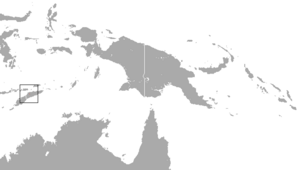Timorese horseshoe bat facts for kids
Quick facts for kids Timorese horseshoe bat |
|
|---|---|
| Conservation status | |
| Scientific classification | |
| Genus: |
Rhinolophus
|
| Species: |
montanus
|
 |
|
| Timorese horseshoe bat's range | |
| Synonyms | |
|
|
The Timorese horseshoe bat (Rhinolophus montanus) is a special type of bat that lives only in Timor-Leste, a country in Southeast Asia. It's known for its unique nose shape, which looks a bit like a horseshoe.
Contents
What is the Timorese Horseshoe Bat?
This bat was first described in 1979 by a scientist named Robert Goodwin. At first, it was thought to be a subspecies of another bat, the large-eared horseshoe bat. Its full scientific name back then was Rhinolophus philippinensis montanus.
How Did It Get Its Name?
In 2002, another scientist, Csorba, studied the bat closely. He found that it was different enough to be its own unique species. So, its name became Rhinolophus montanus. The word "montanus" comes from Latin and means "montane" or "from the mountains." Goodwin chose this name because the first bat found was high up, about 1,220 meters (4,000 feet) above sea level.
How Does the Timorese Horseshoe Bat Live?
The Timorese horseshoe bat is a nocturnal animal. This means it is active at night. During the day, it rests in safe places like caves.
Where Do They Sleep?
Unlike some bats that live in huge groups, these bats prefer smaller gatherings. They usually roost, or sleep, in groups of about six or seven bats. When they rest, they like to hang from the ceilings of caves. They don't hide in small cracks or crevices. Each bat also keeps a little space from the others. Sometimes, they share their roosting caves with other bat species. These can include the Creagh's horseshoe bat, the western bent-winged bat, and the small bent-winged bat.
Where Can You Find the Timorese Horseshoe Bat?
The first Timorese horseshoe bats ever studied were found in the Quoto Lou Caves in Timor-Leste. These caves are about 1,220 meters (4,000 feet) above sea level. Interestingly, these caves are not natural. They were dug by the Japanese during their time in East Timor. The caves are located near a town called Ermera.
Other Places They've Been Found
Scientists have also heard these bats using special equipment called bat detectors. These sounds were picked up near Laleia, in the Nino Konis Santana National Park, and near Betano. This helps scientists know where else these bats might live.
Why Is the Timorese Horseshoe Bat Endangered?
The Timorese horseshoe bat is currently listed as an endangered species by the IUCN. This means it is at a high risk of disappearing forever.
What Threats Do They Face?
Scientists are worried because the area where these bats live is very small, less than 500 square kilometers (193 square miles). They are also threatened by things that destroy their homes, like habitat destruction. People disturbing their roosting caves is another big problem for them. Protecting their caves and natural spaces is very important to help these bats survive.


